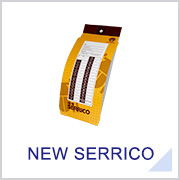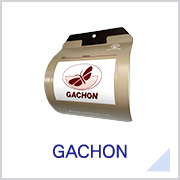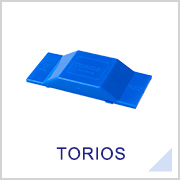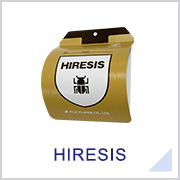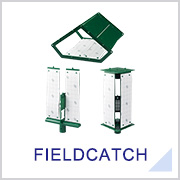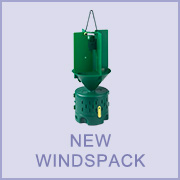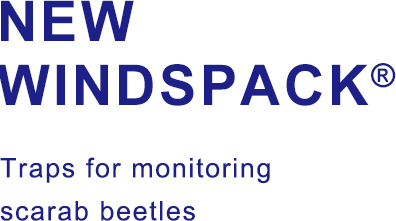
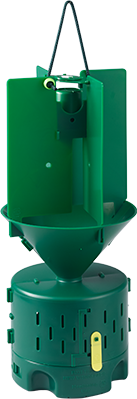
The target insects have a wide outdoor habitat range, including golf courses, orchards, vegetable fields, and horticultural facilities where they directly or indirectly attack raw produce by eating and destroying roots, leaves, and flowers. NEW WINDSPACK is capable of efficient monitoring, using lures for each type of scarab beetle and a specialized trap designed with the nature of these insects in mind.

-
Japanese beetle
Scientific name: Popillia japonica


Adults are 9.0 to 13.5 mm long, with a compact oval shape. The head and thorax are green to black, while the wings are reddish copper green and in rare cases black. A distinctive feature is the patches and tufts of white hair (setae) on their sides. The larvae feed on the roots of lawn and pasture grasses and on humic substances. The adults feed on pasture grass, weeds, and the leaves and flowers of kidney beans, adzuki and other legumes, and of apples, sweet cherries, grapes, roses, and knotweed. Emerging from June to September, the adults are diurnal. Normally one new generation is born per year, and in cold areas, one every two years.
-
Soybean beetle
Scientific name: Anomala rufocuprea


Adults are 12.5 to 17.5 mm long, with a medium-size long-oval shape. There are several variants in body color of these beetles, which can be reddish copper, copper, coppery green, green, deep blue, blackish blue, or even bluish purple. They have a dull metallic luster. The larvae mainly feed on the roots of grasses and wheat, and on humic substances. The adults feed on the leaves of soybeans and other legumes, fruit trees, and broad-leaved trees, causing widespread damage. They emerge from June to September. After sunset, adults tend to fly around for two or three hours before settling down for their feeding damage. They are attracted to light in nighttime. Normally one new generation is born per year, and in cold areas one every two or three years.
-
Cupreous chafer
Scientific name: Anomala cuprea


Adults are large-size at 17.0 to 25.0 mm long. The body is an overall bluish copper color, sometimes green, and has a dull luster. They have fine spots on the head, thorax, and dorsal surface. Emerging from June to September, the adults are nocturnal and attracted to light. In daytime, they curl up leaves and hide inside them. One new generation is born each year. The larvae damage root tubers and root vegetables such as sweet potatoes and taro, leaving eating traces on the surface. Strawberries, peanuts, fruit trees, garden shrubs and many other plants are also affected by them. Adults cause damage to chestnut trees, grape vines, persimmon, and other fruit trees, to the leaves of legume plants, and to rose petals.
-
Anomala schoenfeldti
Scientific name: Anomala schoenfeldti


Adults are relatively compact in size, at 9.0 to 14.0 mm long. The dorsal surface is yellowish brown to reddish brown, and the ventral surface is yellowish brown. The dorsal surface has a strongly metallic luster of greenish copper to purplish copper coloration. Emerging from May to August, the adults take to low flight after sunset. They are attracted to light. One new generation is born per year. In recent years their distribution has spread to the Tohoku region of Japan. They are found mainly in grassy sand dunes along seacoasts, and have been seen also in grasslands and chestnut trees. The larvae feed mainly on the roots of grasses.
-
Anomala octiescostata
Scientific name: Anomala octiescostata


Adults are compact in size, at 9.0 to 13.0 mm long. The body color ranges from reddish copper to greenish copper, while the underside and legs are reddish copper to blackish copper; and they have a metallic luster. Emerging from April to June, the male adults take flight in large numbers on sunny days. One new generation is born per year. Northern Kanto was thought to be their northernmost limit, but lately they have been seen farther north. Mainly the larvae feed on the roots of grasses. The adults feed on the leaves of maple and other trees, and occasionally persimmon trees.
-
Oriental beetle
Scientific name: Blitopertha orientalis


Adults are compact in size, at 8.0 to 13.5 mm long. They are yellowish brown, with black spotted patterns developing to various degrees. Completely black individuals are also to be found. Emerging from May to September, the adults are nocturnal but can also be observed in daytime. One new generation is born per year. They appear in grasslands and along riverbeds, but are also commonly seen in urban areas. The larvae have wide feeding habits, damaging various types of grasses. Adults are harmful to leaves of broad-leaved trees and rose petals, and in Hawaii are known as sugarcane pests.
-
Hoplia communis
Scientific name: Hoplia communis


Adults are compact in size, at 5.5 to 8.5 mm long. The body color is pale greenish yellow, and the dorsal surface is covered with round yellow scales. The larvae mainly feed on the roots of grasses, while adults harm tree leaves. Appearing from May to July, they are distributed in plains and low mountain areas. Care must be taken in their identification, since in some regions the y emerge at the same time as hoplia communis.
-
Pale brownish chafer
Scientific name: Phyllopertha diversa


Adults are 7.0 to 9.5 mm long, with a compact long-oval shape. The head and thorax are black, while the wings are yellowish brown and shiny. They have hairs and spots on the thorax and dorsal surface. The larvae feed on plant roots. Damage is especially great in lawns and grasslands, causing the grass to turn yellow around October. Adults burrow into maple leaves and rose flowers, eating petals and pollen. Appearing from April to June, adults fly near ground level in mid-day, from around 10:00 a.m. to 2:00 p.m. One new generation is born per year. They inhabit places with relatively low plants.
-
Anomala osakana
Scientific name: Anomala osakana


Adults are medium-size at 11.0 to 16.5 mm long. The body color is yellowish brown to reddish brown, with dark green markings on the head and thorax. The larvae feed mainly on the roots of lawn grass, and are common in golf courses. Adults are said to hardly eat anything. Emerging from June to July, they are attracted to light.
-
Green chafer
Scientific name: Anomala albopilosa


Adults are 17.5 to 25.0 mm long, with a large long-oval shape. The dorsal surface is green to reddish green, with a dull luster. The ventral surface and legs are reddish brown to copper color, with a dull luster. A distinctive feature is the golden hairs ornamenting the tail end. The larvae feed mainly on the roots of sugarcane, sweet potato plants, and pineapple trees. Adults feed on fruit trees such as loquat. These insects have wide feeding habits, damaging various types of crops. Emerging from April to late October, they are attracted to light. They have been spreading northward rapidly and are becoming widely distributed.
-
Yellowish elongate chafer
Scientific name: Heptophylla piceasa


Adults are compact in size, at 10.0 to 14.0 mm long. The body color is yellowish brown, and moderately shiny. They change from bright to dark colors. The larvae mainly feed on roots of tea plants and larch saplings, as well as of garden plants such as rhododendrons and azaleas. Honeysuckle plants are also affected by them. Adults feed on leaves of garden plants and other vegetation. They are a major threat to tea plants and shrubs. Emerging from May to September (the peak emergence time is June on flatland), they are nocturnal and attracted to light.
-
Lineate chafer
Scientific name: Anomala testaceipes


Adults are 14.5 to 20.0 mm long, with a medium-size long-oval shape. The body is generally yellowish brown, but in some cases green, brown and other colors. The four longitudinal streaks on each of the left and right wings are distinctive. The larvae feed on the roots of grasses, legume plants, wheat grasses, buckwheat, and coniferous trees. Adults feed on the leaves of coniferous trees. Emerging from June to September, they are attracted to light.
-
Shiny chafer
Scientific name: Anomala lucens


Adults are medium-size at 13.5 to 18.5 mm long. The dorsal surface color is green to reddish copper to brown, and has a dull luster. The larvae mainly feed on the roots of legume plants, wheat grasses, fruit trees and other trees. Adults feed on the leaves of fruit trees. Emerging from June to September, they are attracted to light.
-
Oriental flower beetle
Scientific name: Protaetia orientalis


Adults are large insects 20.0 to 26.5 mm long. Body coloration varies from dark copper to greenish copper and reddish copper, with pale white markings. The larvae eat leaf mold and compost, while adults are attracted to tree sap, flower nectar, and ripe fruits. Emerging from late April to October, they hibernate over winter in the larval or adult stage, with one new generation born per year.

The traps can be reused by replacing the lures.
Assembly and setting are simple. Captured insects are easier to remove now that the opening has been made five times larger than the older model.
The volume of the container can be adjusted in two stages based on the capture situation. Choosing a smaller volume enables the device to be set closer to ground level, increasing the capture rate of low-flying beetles.

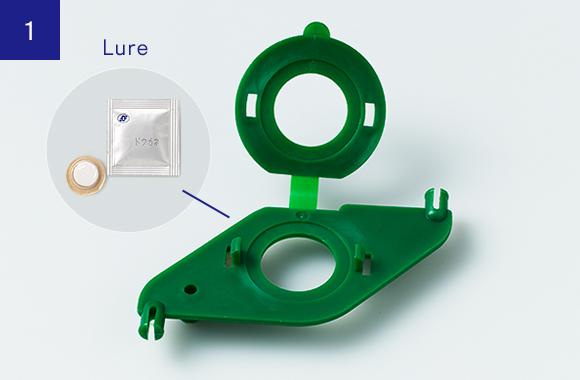
(A) Remove one lure and place it in the holder.
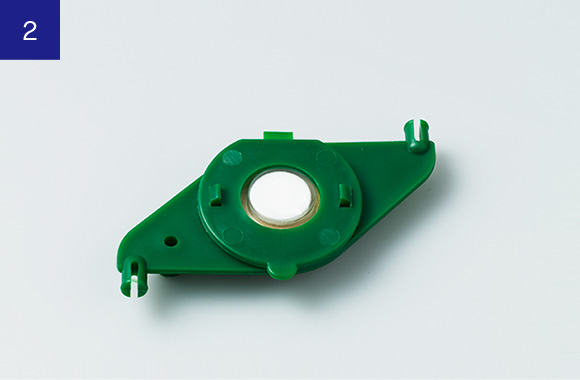
(B) Close the holder cover.
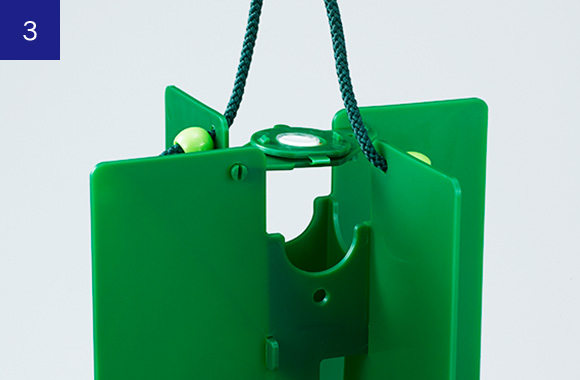
(C) Mount the bottle on top of the trap and place it for use.
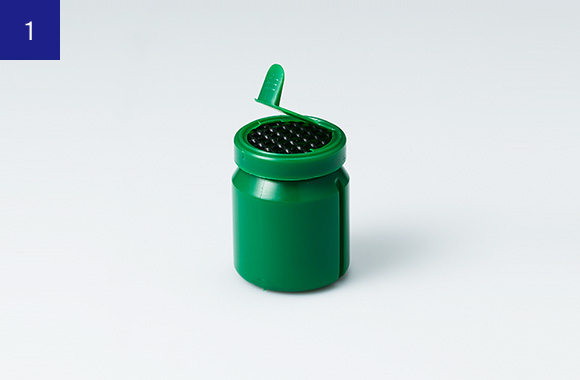
(A) Open the bottle cap.
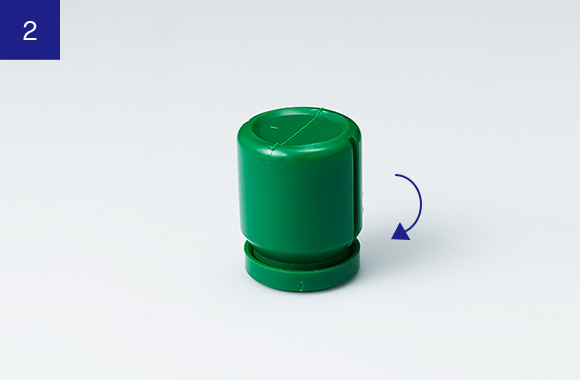
(B) Turn the bottle upside down.
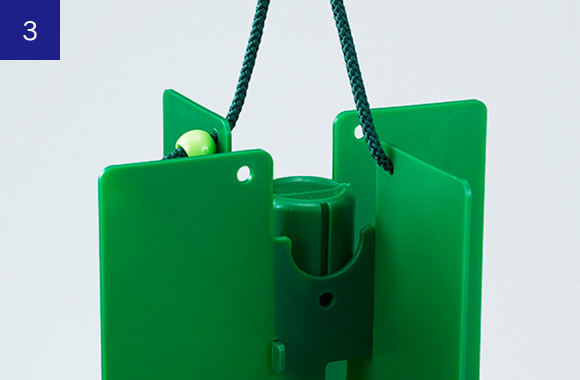
(C) Mount the bottle on top of the trap and place it for use.
Place the traps at a suitable height for each species of beetle.
(A) Suspending from a tree
(Make sure it is not concealed by leaves)
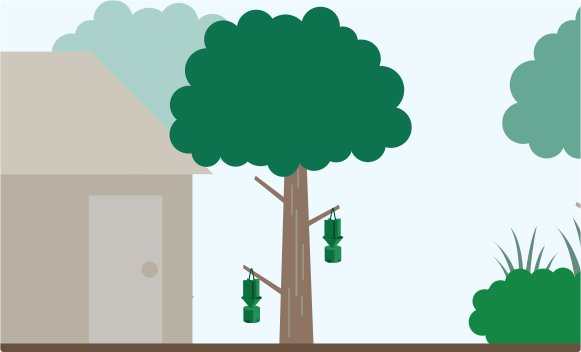
(B) Suspending from a pole
Note: Recommended heights are the same for both tree and pole suspension
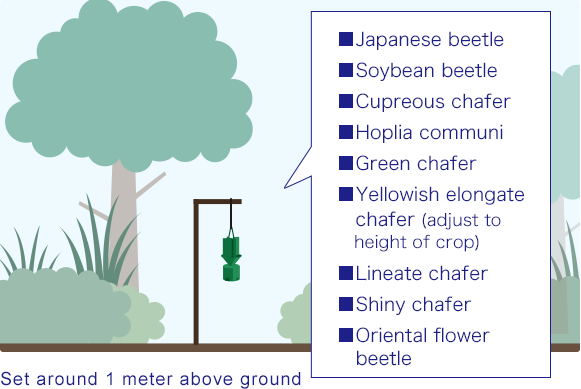
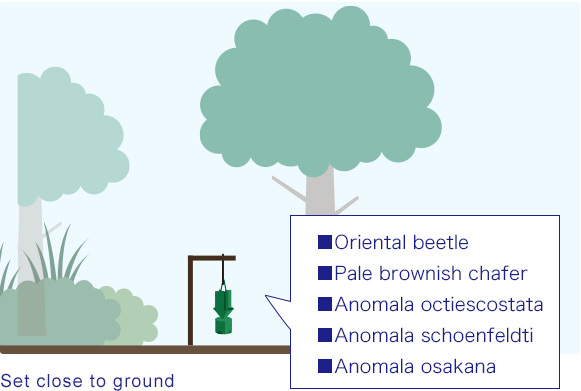
- Set in a well-ventilated location. (If set in a woods or other area with poor air circulation, it may not perform adequately.)
- An attraction range of from 50 to 100 meters can be expected as a general rule.
- Adjust the trap height depending on the target species of beetle.
- Dispose of the captured insects before the trap becomes full. If captured insects are left in the trap for an extended time, they will decompose and reduce the attraction
effectiveness. (At peak emergence times, the trap can become full in one day.)
*When using NEW WINDSPACK for multiple species at the same time, setting lures too close together may cause cross-interference. Keep the traps at least 10 meters apart.
*Use within the designated shelf life.
*Store at room temperature in a dark location, avoiding direct sunlight.
*To maintain quality, do not store in a refrigerator or at temperatures above 40°C.

Trap set
- Trap and lures (different for each insect species), holders/package
Lure set
- Lures (different for each insect species), holders/package
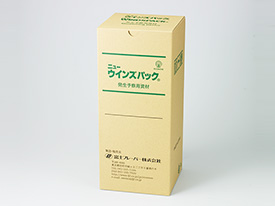
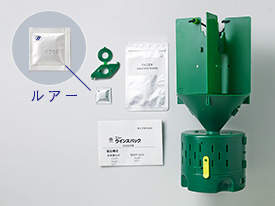
| Target scarab beetle | Especially effective for | Product specifications | ||
| Tablets | Bottle | Attractant | ||
| Japanese beetle | Lawn maintenance, growing legumes or grapes | ○ | ○ | Sex pheromone attracting males and food substance attracting both sexes |
| Soybean beetle | Lawn maintenance, growing legumes or grapes | ○ | ○ | Sex pheromone attracting males and food substance attracting both sexes |
| Japanese beetle, Soybean beetle*1 |
- | ○ | ○ | Sex pheromone attracting males and food substance attracting both sexes |
| Cupreous chafer | Lawn maintenance, growing legumes or grapes Adult feed on the leaves of fruit trees. |
○ | ○ | Sex pheromone attracting males and food substance attracting both sexes |
| Oriental beetle | Lawn maintenance, growing flowers | ○ | ー | Sex pheromone attracting males |
| Pale brownish chafer | Lawn maintenance | ー | ○ | Sex pheromone attracting males |
| Anomala octiescostata | Lawn maintenance | ○ | ー | Sex pheromone attracting males |
| Anomala schoenfeldti | Lawn maintenance, growing legumes or grapes | ○ | ○ | Sex pheromone attracting males and food substance attracting both sexes |
| Hoplia communis | Lawn maintenance | ー | ○ | Food substance attracting both sexes |
| Anomala osakana | Lawn maintenance | ○ | ー | Sex pheromone attracting males |
| Green chafer | Lawn maintenance, growing legumes or grapes or other fruits | ○ | ー | Sex pheromone attracting males |
| Yellowish elongate chafer | Maintaining lawns, honeysuckle, etc. | ○ | ー | Sex pheromone attracting males |
| Lineate chafer*2 | Maintaining lawns where coniferous trees such as cedar or cypress are present | ○ | ○ | Sex pheromone and food substance |
| Shiny chafer*2 | Legumes, pasture and lawn maintenance | ○ | ○ | Sex pheromone and food substance |
| Oriental flower beetle | Growing flowers, chestnuts, and maintenance of oleander shrubs | ○ | ー | Food substance attracting both sexes |
*1 In areas with many soybean beetles present, use the soybean beetle lure.
*2 In areas where cupreous chafers are present, many of them may be captured.
















